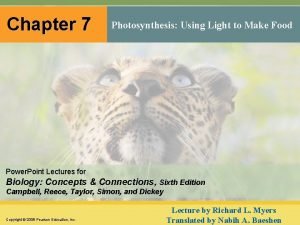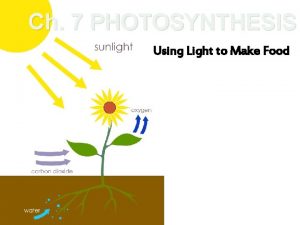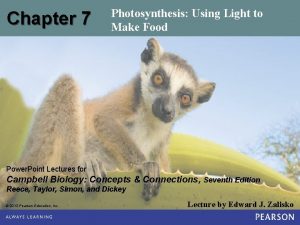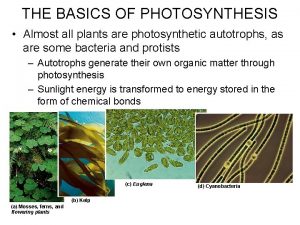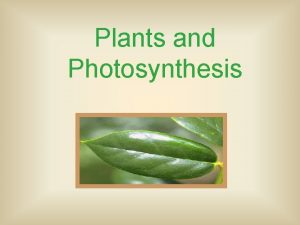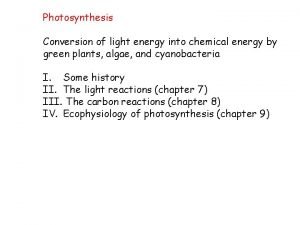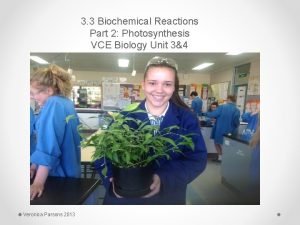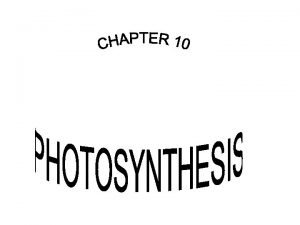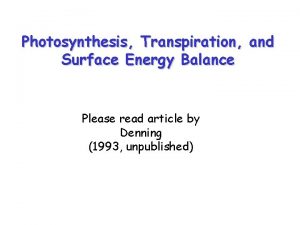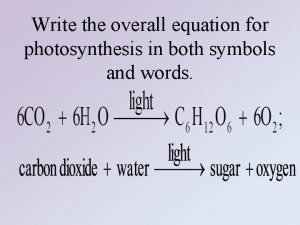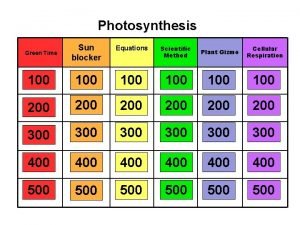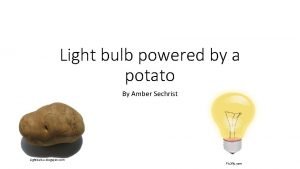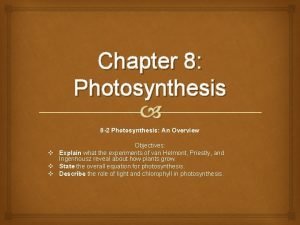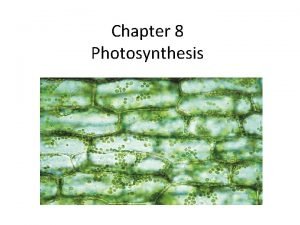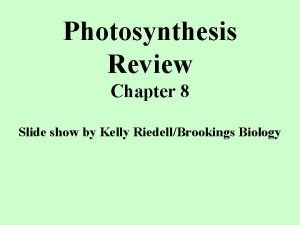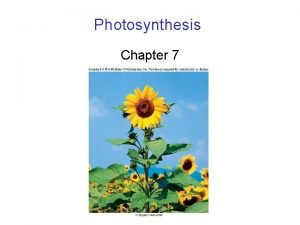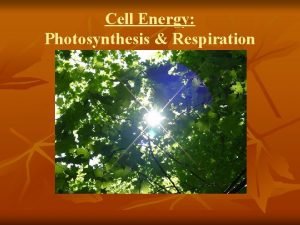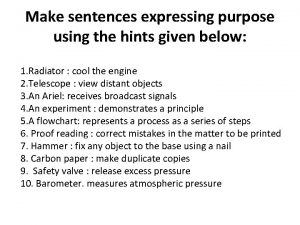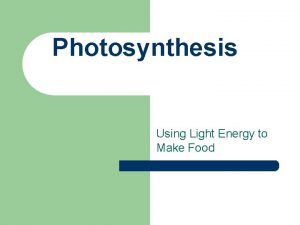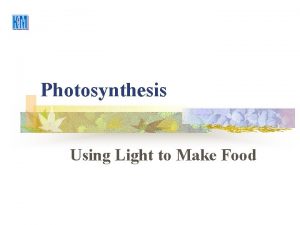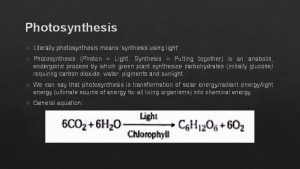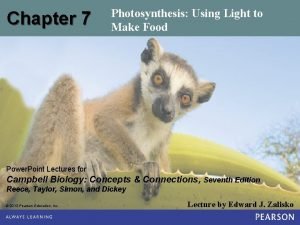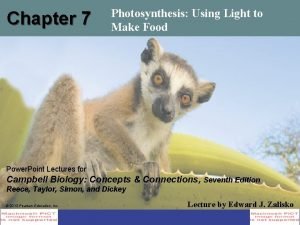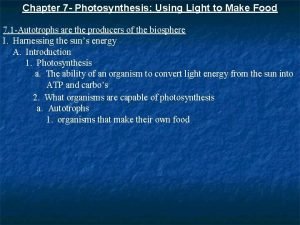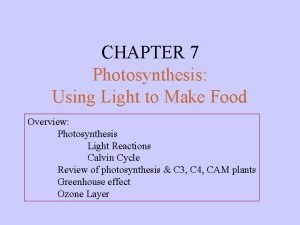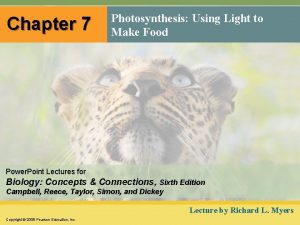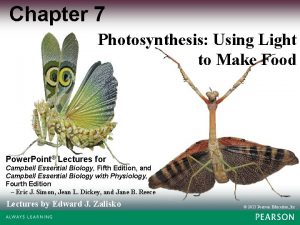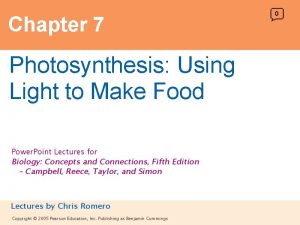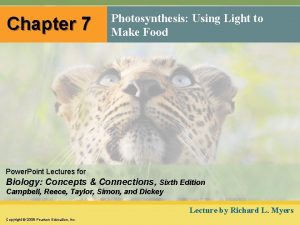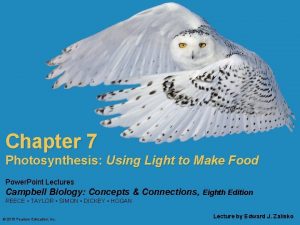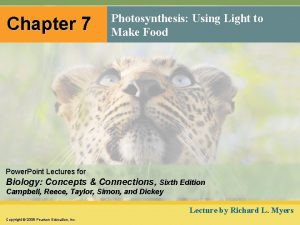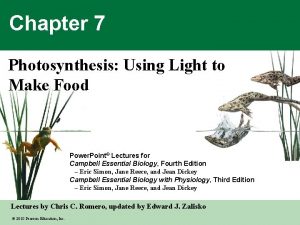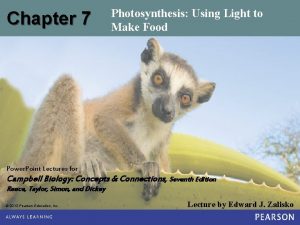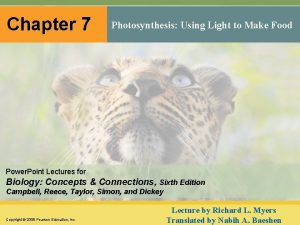Chapter 7 Photosynthesis Using Light to Make Food





































- Slides: 37

Chapter 7 Photosynthesis: Using Light to Make Food Power. Point Lectures for Biology: Concepts & Connections, Sixth Edition Campbell, Reece, Taylor, Simon, and Dickey Copyright © 2009 Pearson Education, Inc. Lecture by Richard L. Myers Translated by Nabih A. Baeshen

Introduction: Plant Power § Plants use water and atmospheric carbon dioxide to produce a simple sugar and liberate oxygen – Earth’s plants produce 160 billion metric tons of sugar each year through photosynthesis, a process that converts solar energy to chemical energy – Sugar is food for humans and for animals that we consume Light energy C 6 H 12 O 6 6 CO 2 + 6 H 2 O Carbon dioxide Water Photosynthesis Glucose + 6 O 2 Oxygen gas

AN OVERVIEW OF PHOTOSYNTHESIS Copyright © 2009 Pearson Education, Inc.

7. 1 Autotrophs are the producers of the biosphere § Autotrophs are living things that are able to make their own food without using organic molecules derived from any other living thing – Autotrophs that use the energy of light to produce organic molecules are called photoautotrophs – Most plants, algae and other protists, and some prokaryotes are photoautotrophs Copyright © 2009 Pearson Education, Inc. Kelp, a large algae ﺍﻟﻜﻴﻠﺐ ﻃﺤﻠﺐ ﻛﺒﻴﺮ

7. 1 Autotrophs are the producers of the biosphere § The ability to photosynthesize is directly related to the structure of chloroplasts – Chloroplasts are organelles consisting of photosynthetic pigments, enzymes and other molecules grouped together in membranes Micrograph of cyanobacteria (photosynthetic bacteria) ( Copyright © 2009 Pearson Education, Inc.

7. 2 Photosynthesis occurs in chloroplasts in plant cells § Chloroplasts are the major sites of photosynthesis in green plants – Chlorophyll, Chlorophyll an important light absorbing pigment in chloroplasts, is responsible for the green color of plants – Chlorophyll plays a central role in converting solar energy to chemical energy Copyright © 2009 Pearson Education, Inc.

7. 2 Photosynthesis occurs in chloroplasts in plant cells Leaf Cross Section Mesophyll Vein Stoma CO 2 Mesophyll Cell The location and structure of chloroplasts Chloroplast

7. 2 Photosynthesis occurs in chloroplasts in plant cells § Chloroplasts are concentrated in the cells of the mesophyll, the green tissue in the interior of the leaf § Stomata are tiny pores in the leaf that allow carbon dioxide to enter and oxygen to exit § Veins in the leaf deliver water absorbed by roots Copyright © 2009 Pearson Education, Inc.

Chloroplast Outer and inner membranes Intermembrane space Thylakoid Stroma Granum

7. 2 Photosynthesis occurs in chloroplasts in plant cells § An envelope of two membranes encloses the stroma, the dense fluid within the chloroplast § A system of interconnected membranous sacs called thylakoids segregates the stroma from another compartment, the thylakoid space –Thylakoids are concentrated in stacks called granam Copyright © 2009 Pearson Education, Inc.

7. 3 Plants produce O 2 gas by splitting water § Scientists have known for a long time that plants produce O 2, but early on they assumed it was extracted from CO 2 taken into the plant – Using a heavy isotope of oxygen, 18 O, they showed with tracer experiments that O 2 actually comes from H 2 O Oxygen bubbles on the leaves of an aquatic plant Copyright © 2009 Pearson Education, Inc.

Experiment 1 6 CO 2 + 12 H 2 O C 6 H 12 O 6 + 6 H 2 O + 6 O 2 Not labeled Experiment 2 6 CO 2 + 12 H 2 O C 6 H 12 O 6 + 6 H 2 O + 6 O 2 Labeled Experiments tracking the oxygen atoms in photosynthesis

Fates of all the atoms in photosynthesis Reactants: Products: 6 CO 2 C 6 H 12 O 6 12 H 2 O 6 O 2

7. 4 Photosynthesis is a redox process, as is cellular respiration § Photosynthesis, like respiration, is a redox (oxidation-reduction) process – Water molecules are split apart by oxidation, which means that they lose electrons along with hydrogen ions (H+) – Then CO 2 is reduced to sugar as electrons and hydrogen ions are added to it Copyright © 2009 Pearson Education, Inc.

Photosynthesis (uses light energy) Reduction 6 CO 2 + 6 H 2 O C 6 H 12 O 6 + 6 O 2 Oxidation Cellular respiration (releases chemical energy) Oxidation C 6 H 12 O 6 + 6 O 2 6 CO 2 + 6 H 2 O + E Reduction

7. 4 Photosynthesis is a redox process, as is cellular respiration § Recall that cellular respiration uses redox reactions to harvest the chemical energy stored in a glucose molecule – This is accomplished by oxidizing the sugar and reducing O 2 to H 2 O – The electrons lose potential as they travel down an energy hill, the electron transport system – In contrast, the food-producing redox reactions of photosynthesis reverse the flow and involve an uphill climb Copyright © 2009 Pearson Education, Inc.

H 2 O Chloroplast Light NADP+ ADP P LIGHT REACTIONS (in thylakoids) An overview of the two stages of photosynthesis that take place in a chloroplast

H 2 O Chloroplast ﺧﻀﺮﺍﺀ ﺑﻼﺳﺘﻴﺪﺓ Light ﺿﻮﺀ NADP+ ADP P LIGHT REACTIONS (in thylakoids) ATP ﺍﻟ ﻴﻜﺘ ﺮﻭﻧ ﺎﺕ NADPH O 2 An overview of the two stages of photosynthesis that take place in a chloroplast ﻧﻈﺮﺓ ﺷﺎﻣﻠﺔ ﻟﻤﺮﺣﻠﺘﻲ ﺍﻟﺒﻨﺎﺀ ﺍﻟﻀﻮﺋﻲ ﺍﻟﺘﻲ ﺗﺘﻢ ﻓﻲ ﺍﻟﺒﻼﺳﺘﻴﺪﺓ ﺍﻟﺨﻀﺮﺍﺀ

7. 5 Overview: The two stages of photosynthesis are linked by ATP and NADPH § Actually, photosynthesis occurs in two metabolic stages First stage – One stage involves the light reactions – In the light reactions, light energy is converted in the thylakoid membranes to chemical energy and O 2 – Water is split to provide the O 2 as well as electrons Copyright © 2009 Pearson Education, Inc.

7. 5 Overview: The two stages of photosynthesis are linked by ATP and NADPH § H+ ions reduce NADP+ to NADPH, which is an electron carrier similar to NADH – NADPH is temporarily stored and then shuttled into the Calvin cycle where it is used to make sugar – Finally, the light reactions generate ATP Copyright © 2009 Pearson Education, Inc.

7. 5 Overview: The two stages of photosynthesis are linked by ATP and NADPH Second stage § The second stage is the Calvin cycle, which occurs in the stroma of the chloroplast – It is a cyclic series of reactions that builds sugar molecules from CO 2 and the products of the light reactions – During the Calvin cycle, CO 2 is incorporated into organic compounds, a process called carbon fixation Copyright © 2009 Pearson Education, Inc.

7. 5 Overview: The two stages of photosynthesis are linked by ATP and NADPH NADH ﻭ ATP ﺗﺮﺗﺒﻂ ﻣﺮﺣﻠﺘﻲ ﺍﻟﺒﻨﺎﺀ ﺍﻟﻀﻮﺋﻲ ﺑـ : ﻧﻈﺮﺓ ﺷﺎﻣﻠﺔ § NADPH produced by the light reactions provides the electrons for reducing carbon in the Calvin cycle – ATP from the light reactions provides chemical energy for the Calvin cycle – The Calvin cycle is often called the dark (or light-independent) reactions Copyright © 2009 Pearson Education, Inc.


PHOTOSYNTHESIS REVIEWED AND EXTENDED Copyright © 2009 Pearson Education, Inc.

7. 11 Review: Photosynthesis uses light energy, CO 2, and H 2 O to make food molecules § The chloroplast, which integrates the two stages of photosynthesis, makes sugar from CO 2 – All but a few microscopic organisms depend on the food-making machinery of photosynthesis – Plants make more food than they actually need and stockpile it as starch in roots, tubers, and fruits Copyright © 2009 Pearson Education, Inc.

CO 2 H 2 O Summary of the chemical processes of photosynthesis Chloroplast Light NADP+ ADP + P Photosystem II Ru. BP CALVIN CYCLE (in stroma) 3 -PGA Electron transport chains Thylakoid Membranes Photosystem I ATP NADPH Stroma G 3 P O 2 Sugars LIGHT REACTIONS CALVIN CYCLE Cellular respiration Cellulose Starch Other organic compounds

PHOTOSYNTHESIS, SOLAR RADIATION, AND EARTH’S ATMOSPHERE Copyright © 2009 Pearson Education, Inc.

7. 13 CONNECTION: Photosynthesis moderates global warming § The greenhouse effect results from solar energy warming our planet – Gases in the atmosphere (often called greenhouse gases), including CO 2, reflect heat back to Earth, keeping the planet warm and supporting life – However, as we increase the level of greenhouse gases, Earth’s temperature rises above normal, initiating problems Copyright © 2009 Pearson Education, Inc.

7. 13 CONNECTION: Photosynthesis moderates global warming § Increasing concentrations of greenhouse gases lead to global warming, a slow but steady rise in Earth’s surface temperature – The extraordinary rise in CO 2 is mostly due to the combustion of carbon-based fossil fuels – The consequences of continued rise will be melting of polar ice, changing weather patterns, and spread of tropical disease Copyright © 2009 Pearson Education, Inc.

7. 13 CONNECTION: Photosynthesis moderates global warming § Perhaps photosynthesis can mitigate the increase in atmospheric CO 2 – However, there is increasing widespread deforestation, which aggravates the global warming problem Copyright © 2009 Pearson Education, Inc.

Plants growing in a greenhouse

Some heat energy escapes into space Sunlight Atmosphere Radiant heat trapped by CO 2 and other gases CO 2 in the atmosphere and global warming





 Chapter 7 photosynthesis using light to make food
Chapter 7 photosynthesis using light to make food Using light to make food
Using light to make food Using light to make food
Using light to make food Light light light chapter 23
Light light light chapter 23 Light light light chapter 22
Light light light chapter 22 Light light light chapter 22
Light light light chapter 22 How photosynthesis takes place
How photosynthesis takes place Green plants make their own food by photosynthesis
Green plants make their own food by photosynthesis Inputs of light reactions in photosynthesis
Inputs of light reactions in photosynthesis Autotroph
Autotroph Chemical form of energy
Chemical form of energy Light dependent phase of photosynthesis
Light dependent phase of photosynthesis Reaction of photosynthesis
Reaction of photosynthesis Structure of chlorophyll
Structure of chlorophyll Photosynthesis transforms light energy into chemical energy
Photosynthesis transforms light energy into chemical energy Unit 2 food food food
Unit 2 food food food Food chain food chain food chain
Food chain food chain food chain Word equation for photosynthesis
Word equation for photosynthesis The food that plants produce during photosynthesis is
The food that plants produce during photosynthesis is A food webs are
A food webs are Make the lie big make it simple
Make the lie big make it simple Steve angrisano go make a difference
Steve angrisano go make a difference Dawes plan
Dawes plan Pare cooking definition
Pare cooking definition Potato powered light bulb
Potato powered light bulb Othello put out the light
Othello put out the light Difference between light dependent and light independent
Difference between light dependent and light independent It is the bouncing off of light
It is the bouncing off of light What materials do block light
What materials do block light 8-2 photosynthesis an overview
8-2 photosynthesis an overview Chapter 8 section 2 photosynthesis
Chapter 8 section 2 photosynthesis Chapter 9 lesson 2 photosynthesis an overview
Chapter 9 lesson 2 photosynthesis an overview Atp and adp cycle
Atp and adp cycle What are the products of photosynthesis?
What are the products of photosynthesis? Chapter 7 photosynthesis
Chapter 7 photosynthesis How do plants get glucose
How do plants get glucose Make sentences using the past simple and past continuous
Make sentences using the past simple and past continuous Write 2 sentences by using expressing purpose
Write 2 sentences by using expressing purpose
